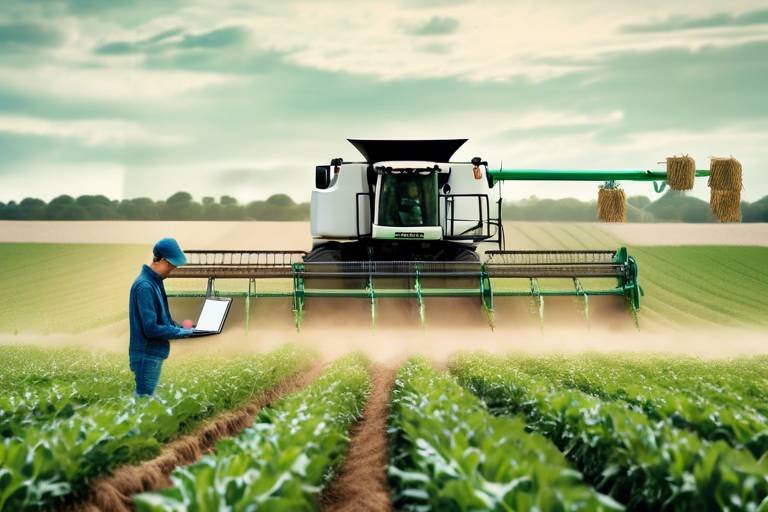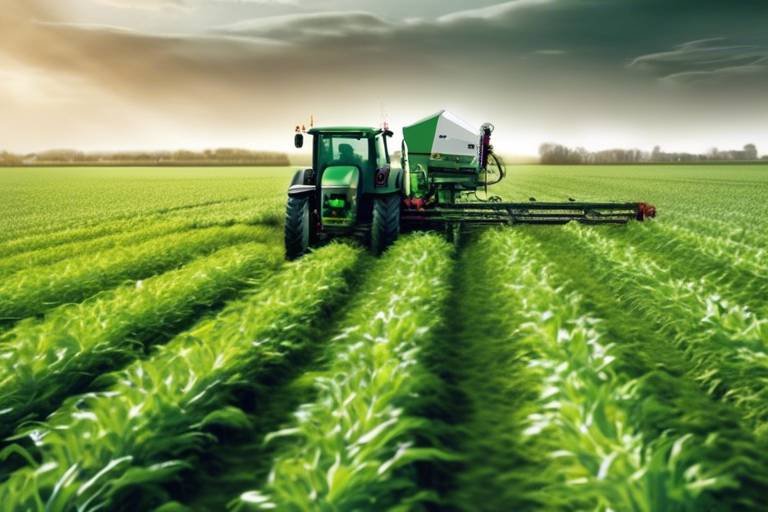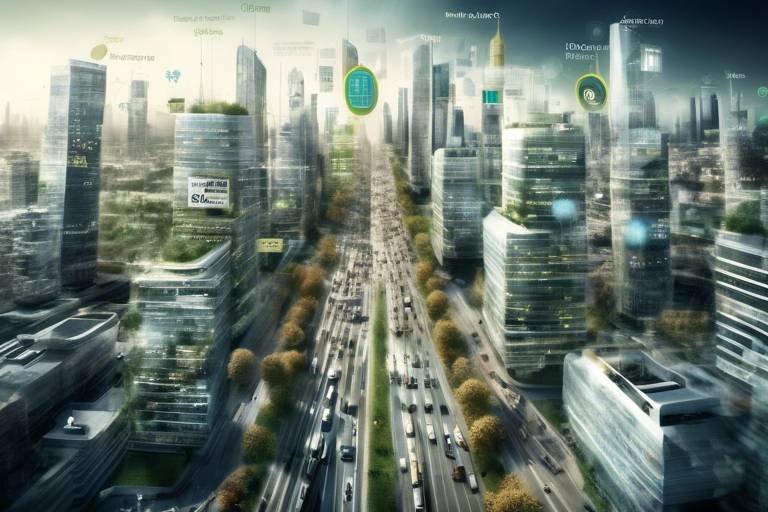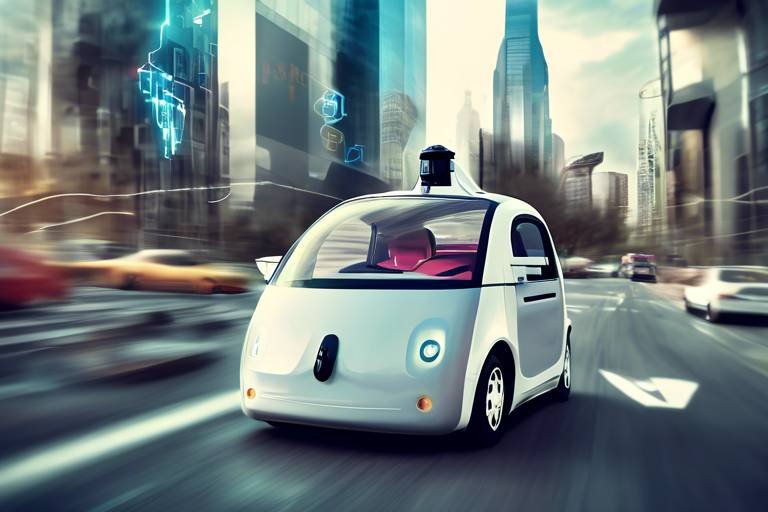The Future of Agriculture: AI and Big Data
As we step into a new era of agriculture, the integration of artificial intelligence (AI) and big data is transforming the way we cultivate, manage, and sustain our food systems. Imagine a world where farmers can predict crop yields with pinpoint accuracy, optimize water usage to the last drop, and make decisions based on real-time data. This isn't science fiction; it's the reality of modern farming, and it's reshaping the agricultural landscape globally.
The marriage of AI and big data is not just about technology; it's about enhancing productivity while ensuring sustainability. With the global population projected to reach 9.7 billion by 2050, the demand for food is skyrocketing. Farmers are faced with the daunting challenge of increasing production while minimizing environmental impact. Here’s where the power of AI and big data comes into play. By harnessing these technologies, farmers can achieve more with less, promoting a future where agriculture is both efficient and sustainable.
AI technologies are revolutionizing precision farming, allowing for data-driven decision-making. This means that farmers can utilize advanced analytics and machine learning to optimize resource usage, leading to improved crop yields. Instead of relying solely on intuition or traditional farming methods, farmers can now access a wealth of information that guides their decisions. For instance, AI can analyze weather patterns, soil conditions, and crop health, providing actionable insights that can significantly enhance productivity.
But what does this look like in practice? Imagine a farmer using IoT sensors to monitor soil moisture levels in real-time. With this data, they can determine the exact amount of water needed for their crops, reducing waste and conserving precious resources. Or consider the use of drones equipped with high-resolution cameras to survey fields from above. These drones can identify areas that require attention, such as pest infestations or nutrient deficiencies, enabling farmers to intervene swiftly and effectively.
As we delve deeper into the world of big data analytics, it's clear that the implications for agriculture are profound. Farmers are now able to gather and analyze vast amounts of data, leading to insights that drive efficiency and enhance overall farm management strategies. Techniques like data collection through IoT sensors, drones, and satellite imagery provide a comprehensive view of agricultural conditions. This data-driven approach empowers farmers to make informed decisions that can lead to higher yields and lower costs.
In conclusion, the future of agriculture is bright with the integration of AI and big data. These technologies not only enhance productivity but also pave the way for sustainable farming practices that are crucial in today’s world. As we continue to innovate and embrace these advancements, we can look forward to a future where agriculture meets the needs of a growing population while protecting our planet.
- What is precision farming? Precision farming is an agricultural practice that uses technology, such as AI and big data, to monitor and manage field variability in crops to optimize yields and resource use.
- How does AI improve crop yields? AI improves crop yields by analyzing data on weather, soil conditions, and crop health, allowing farmers to make informed decisions about planting, irrigation, and pest management.
- What are the challenges of implementing AI in agriculture? The challenges include high costs, data privacy concerns, and the need for skilled personnel to analyze and interpret the data effectively.
- Can small-scale farmers benefit from AI and big data? Yes, small-scale farmers can benefit from AI and big data, but they may face barriers such as financial investment and access to technology.

The Role of AI in Precision Farming
Artificial Intelligence (AI) is becoming a game-changer in the world of agriculture, particularly in the realm of precision farming. This innovative approach leverages technology to make farming more efficient and productive. Imagine a world where farmers can predict the optimal time to plant seeds, irrigate crops, and apply fertilizers—all thanks to AI! By utilizing data-driven decision-making, farmers can optimize resource usage and significantly improve crop yields.
At the heart of precision farming lies the ability to analyze vast amounts of data collected from various sources. AI technologies, including machine learning algorithms, can process this data to identify patterns and trends that would be impossible for humans to discern alone. For instance, AI can analyze historical weather data, soil conditions, and crop health metrics to provide actionable insights. This means farmers can make informed decisions that not only enhance productivity but also promote sustainability.
One of the most exciting aspects of AI in precision farming is its capability to optimize resource usage. With AI, farmers can determine the exact amount of water, fertilizers, and pesticides needed for each crop type. This targeted approach reduces waste and minimizes the environmental impact. For example, by using AI-driven irrigation systems, farmers can ensure that each plant receives just the right amount of water, conserving this precious resource while maximizing growth potential.
Moreover, AI can improve crop monitoring by utilizing advanced analytics. Farmers can now receive real-time feedback on crop health, enabling them to take immediate action when issues arise. This proactive approach not only saves time but also helps in preventing potential crop losses. In fact, studies have shown that farms employing AI technologies can see a significant increase in yield, sometimes by as much as 20-30% compared to traditional farming methods.
To illustrate the impact of AI on precision farming, consider the following table:
| AI Application | Benefit | Impact on Yield |
|---|---|---|
| Predictive Analytics | Improves planting schedules | +15% |
| Resource Optimization | Reduces water and fertilizer usage | +20% |
| Crop Health Monitoring | Enables timely interventions | +30% |
In summary, the role of AI in precision farming is not just about technology; it’s about transforming the way we think about agriculture. By embracing AI, farmers can harness the power of data to make smarter decisions, ultimately leading to a more sustainable and productive future. As we move forward, the integration of AI into farming practices will likely become the norm, paving the way for innovations that we can only begin to imagine.
Q: How does AI improve crop yields?
A: AI analyzes data to provide insights on optimal planting times, resource usage, and crop health, allowing farmers to make informed decisions that enhance productivity.
Q: What are the environmental benefits of using AI in agriculture?
A: AI helps optimize resource usage, reducing waste and minimizing the environmental impact of farming practices, such as over-watering and excessive pesticide application.
Q: Is AI technology accessible to small-scale farmers?
A: While AI technology can be costly, there are increasingly affordable solutions and initiatives aimed at helping small-scale farmers access these innovative tools.

Big Data Analytics in Agriculture
In today's fast-paced world, big data analytics is revolutionizing agriculture in ways we never thought possible. Imagine a farmer standing in the middle of a vast field, not just relying on intuition or old-school farming methods, but armed with a treasure trove of data that can predict the best times to plant, irrigate, and harvest. This is the power of big data in agriculture, where insights derived from vast amounts of information lead to enhanced efficiency and sustainability.
Farmers are now equipped with tools that allow them to gather and analyze data from multiple sources, including weather forecasts, soil conditions, and crop performance metrics. By utilizing big data analytics, they can make informed decisions that significantly improve their productivity. For instance, through data analysis, farmers can identify patterns that predict pest infestations or crop diseases before they wreak havoc on their yields. This proactive approach not only saves time but also reduces the reliance on chemical pesticides, promoting a healthier ecosystem.
Moreover, big data analytics enables farmers to optimize their resource usage. By analyzing data on water usage, fertilizer application, and labor costs, farmers can minimize waste and maximize output. This is particularly crucial in a world where resources are becoming increasingly scarce. For example, a study showed that farms using data analytics were able to reduce water consumption by up to 30% while maintaining crop yields. That's a win-win for both farmers and the environment!
To illustrate the impact of big data analytics in agriculture, consider the following table:
| Key Benefits | Impact on Farming |
|---|---|
| Improved Crop Yields | Data-driven insights lead to better planting and harvesting schedules, resulting in higher productivity. |
| Resource Efficiency | Optimizing water and fertilizer usage reduces costs and environmental impact. |
| Pest and Disease Management | Predictive analytics help in early detection and intervention, minimizing crop loss. |
| Market Insights | Farmers can analyze market trends to make informed decisions on crop selection and pricing. |
As we look to the future, the integration of big data analytics in agriculture is not just a trend; it’s becoming a necessity. Farmers who harness the power of data will not only survive but thrive in an increasingly competitive market. The question is, are you ready to embrace this agricultural revolution? In the coming years, those who adapt and innovate will set the stage for a new era of farming that is efficient, sustainable, and capable of feeding the growing global population.
- What is big data analytics in agriculture? Big data analytics in agriculture refers to the process of collecting and analyzing large volumes of data from various sources to improve farming practices and decision-making.
- How can big data improve crop yields? By analyzing data on weather, soil conditions, and pest activity, farmers can make better-informed decisions about planting, fertilizing, and harvesting, leading to improved yields.
- What tools are commonly used for big data analytics in agriculture? Tools such as IoT sensors, drones, and advanced software platforms are commonly used to collect and analyze agricultural data.
- Are there any challenges associated with big data in agriculture? Yes, challenges include high costs of technology, data privacy concerns, and the need for skilled personnel to interpret the data effectively.

Data Collection Techniques
In the ever-evolving landscape of agriculture, play a pivotal role in enhancing farm productivity and sustainability. With the advent of advanced technologies, farmers now have access to a plethora of tools that allow them to gather critical data on various factors affecting crop performance. These techniques not only provide a comprehensive view of agricultural conditions but also empower farmers to make informed decisions. Let's dive into some of the most effective data collection methods being utilized today.
One of the most significant advancements in data collection is the use of IoT sensors. These tiny devices can be strategically placed throughout the farm to monitor soil health, moisture levels, and even weather conditions in real-time. Imagine having a personal assistant that constantly keeps an eye on your crops, alerting you when they need water or nutrients. This real-time data helps farmers optimize their resource usage, ensuring that crops receive exactly what they need when they need it, ultimately leading to healthier plants and higher yields.
Another exciting technology making waves in agriculture is drones. Equipped with high-resolution cameras and various sensors, drones can capture detailed images of fields from above. This aerial perspective allows farmers to assess crop health, identify pest infestations, and monitor irrigation systems more effectively. For instance, a farmer can fly a drone over a field and instantly spot areas where crops are under stress, enabling quick interventions that can save the harvest before it's too late.
Furthermore, satellite imagery has become an indispensable tool for large-scale farming operations. Satellites orbiting the Earth can capture vast amounts of data about land use, crop growth, and environmental changes over time. This information can be analyzed to reveal trends and patterns that inform long-term agricultural strategies. For example, farmers can use satellite data to determine the optimal planting times based on historical weather patterns, thereby maximizing their chances of a successful harvest.
In addition to these technologies, farmers also rely on mobile applications that aggregate data from various sources. These apps can provide farmers with weather forecasts, market prices, and even pest alerts, all in one place. By consolidating data into a user-friendly format, farmers can quickly assess their situation and make decisions that align with their operational goals.
Overall, the integration of these data collection techniques is transforming the agricultural landscape. As farmers embrace these technologies, they are not only enhancing their productivity but also paving the way for a more sustainable future in farming. The ability to collect and analyze data is no longer a luxury; it has become a necessity for those looking to thrive in the competitive world of agriculture.
- What are IoT sensors, and how do they help in farming?
IoT sensors are devices that monitor various environmental factors such as soil moisture, temperature, and humidity, providing real-time data that helps farmers make informed decisions. - How do drones improve crop monitoring?
Drones equipped with cameras can capture high-resolution images of crops from above, allowing farmers to identify health issues and manage resources more effectively. - What role does satellite imagery play in agriculture?
Satellite imagery provides farmers with data on land use and crop growth, helping them make long-term strategic decisions based on environmental trends. - Are there any downsides to using these technologies?
While the benefits are significant, challenges include high initial costs, the need for technical knowledge, and concerns over data privacy.

IoT Sensors in Smart Farming
In the ever-evolving world of agriculture, IoT sensors are emerging as a game-changer, transforming traditional farming into a more efficient and data-driven practice. These sensors are small devices equipped with the ability to collect a plethora of information regarding various environmental factors that influence crop growth. Imagine walking through a lush green field, and every inch of soil is talking to you, sharing secrets about moisture levels, temperature, and nutrient content. This is the reality that IoT sensors bring to the farming landscape.
IoT sensors work by gathering real-time data from the field and transmitting it to farmers, allowing them to make informed decisions. For instance, farmers can monitor soil moisture levels and determine the optimal time for irrigation. This not only conserves water but also ensures that crops receive just the right amount of hydration. By leveraging this technology, farmers can optimize their operations and enhance productivity while minimizing waste.
Moreover, these sensors can be deployed in various forms, including:
- Soil Moisture Sensors: These sensors measure the moisture content in the soil, providing insights into irrigation needs.
- Temperature and Humidity Sensors: They monitor the environmental conditions, helping farmers understand how weather affects crop growth.
- Crop Health Sensors: These devices assess the health of crops by detecting stress levels and nutrient deficiencies.
One of the most significant advantages of IoT sensors is their ability to integrate with other technologies. For example, when combined with drone technology, farmers can achieve a comprehensive view of their fields. Drones can survey large areas quickly, while IoT sensors provide detailed, localized data. This synergy allows for precise interventions, such as targeted fertilization or pest control, which can lead to higher yields and reduced costs.
However, while the benefits of IoT sensors are clear, farmers must also consider the initial investment and ongoing maintenance costs associated with these technologies. Yet, as the saying goes, "you have to spend money to make money." The long-term gains from increased efficiency and productivity often outweigh the upfront costs, making IoT sensors a wise investment for modern farmers.
In conclusion, IoT sensors are revolutionizing smart farming by enabling real-time monitoring and data collection that empowers farmers to make better decisions. As technology continues to advance, we can expect these sensors to become even more sophisticated, further enhancing agricultural practices and contributing to a more sustainable future. The integration of IoT in farming is not just a trend; it's a necessity for those looking to thrive in the competitive agricultural landscape.
- What are IoT sensors? IoT sensors are devices that collect data from the environment, such as soil moisture, temperature, and crop health, and transmit it to farmers for analysis.
- How do IoT sensors benefit farmers? They provide real-time data that helps farmers optimize irrigation, monitor crop health, and make informed decisions, leading to increased productivity and resource efficiency.
- Are IoT sensors expensive to implement? While there is an initial investment, the long-term benefits often outweigh the costs, making them a valuable addition to modern farming.
- Can IoT sensors be integrated with other technologies? Yes, IoT sensors can work alongside drones and other technologies to provide a comprehensive view of agricultural conditions.

Drones for Crop Monitoring
Drones are not just the latest tech gadget; they are becoming a game-changer in the world of agriculture. Imagine hovering above your fields, getting a bird’s-eye view of your crops, and instantly identifying potential problems. That’s exactly what drones can do for farmers today. Equipped with advanced cameras and sensors, these flying machines can capture high-resolution images and gather real-time data on crop health, soil conditions, and even pest infestations. This capability allows farmers to make informed decisions that can significantly enhance their productivity.
Using drones for crop monitoring provides several advantages that traditional farming methods simply cannot match. For instance, drones can cover large areas in a fraction of the time it would take a farmer walking through the fields. This efficiency means that farmers can spend more time focusing on other critical aspects of their operations. Moreover, the data collected by drones can be processed through sophisticated software that uses AI algorithms to analyze crop conditions, enabling farmers to identify issues before they escalate into major problems.
Here are some key benefits of using drones in agriculture:
- Timely Interventions: Drones can quickly identify areas that require attention, such as irrigation needs or pest outbreaks, allowing for prompt action.
- Cost-Effective Monitoring: Regular drone flights can reduce the need for manual labor and minimize the costs associated with crop inspections.
- Data Accuracy: The high-resolution images captured by drones provide precise data that helps in making better agricultural decisions.
- Environmental Impact: By enabling targeted treatments, drones can help reduce the overall use of fertilizers and pesticides, promoting sustainable farming practices.
Furthermore, the integration of drones with other technologies, such as IoT sensors and big data analytics, can create a holistic approach to farm management. For example, while drones provide aerial imagery, IoT sensors can monitor soil moisture levels in real-time. This combined data can lead to highly optimized irrigation schedules, ensuring crops receive just the right amount of water without wastage.
As we look to the future, the role of drones in agriculture is only expected to grow. With advancements in technology, we can anticipate even more sophisticated drone capabilities, including automated flight paths and enhanced data processing features. Farmers who embrace this technology will not only improve their crop yields but also contribute to a more sustainable agricultural landscape.
- How do drones help in pest management? Drones can quickly identify areas of pest infestation, allowing farmers to target those areas with pesticides rather than treating entire fields.
- Are drones expensive to operate? While there is an initial investment, the long-term savings in labor and increased crop yields can offset the costs significantly.
- What kind of data can drones collect? Drones can collect data on crop health, soil conditions, moisture levels, and even predict yields based on their analysis.

Data-Driven Decision Making
In the evolving landscape of agriculture, is not just a trend; it's a revolution. Imagine a farmer standing in the middle of a vast field, armed with insights derived from data rather than mere intuition. This is the new norm, where farmers leverage advanced analytics to make informed choices about their crops, irrigation, and pest management. By harnessing the power of data, farmers can optimize their operations, leading to enhanced productivity and sustainability.
So, what does this really mean? Well, data-driven decision making enables farmers to analyze various factors that influence crop yields. For instance, by examining historical weather patterns, soil health data, and crop performance metrics, farmers can determine the best times for planting and harvesting. This approach minimizes risks and maximizes output, ensuring that every seed sown has the potential to flourish.
Moreover, consider the impact of predictive analytics in agriculture. With the help of AI algorithms, farmers can forecast potential pest infestations or diseases before they occur. This proactive approach allows for timely interventions, reducing crop loss and the need for excessive pesticide use. It's like having a crystal ball that not only predicts the future but also guides farmers on how to navigate challenges effectively.
To illustrate the benefits of data-driven decision making, let's take a look at a simple table that summarizes the key advantages:
| Advantage | Description |
|---|---|
| Improved Efficiency | Data insights help farmers use resources more effectively, reducing waste and costs. |
| Enhanced Yield | Informed decisions lead to better crop management and increased harvests. |
| Risk Mitigation | Predictive analytics help in anticipating problems, allowing for timely actions. |
| Sustainability | Optimizing resource use contributes to environmentally friendly farming practices. |
In conclusion, data-driven decision making is transforming the agricultural sector by empowering farmers with the insights they need to thrive in a competitive market. It’s about turning raw data into actionable strategies that not only enhance productivity but also promote sustainability. As technology continues to advance, the reliance on data will only grow, making it essential for farmers to adapt and embrace this new way of thinking. So, the next time you see a farmer in the field, remember—they're not just cultivating crops; they're cultivating insights that will shape the future of agriculture.
- What is data-driven decision making in agriculture?
Data-driven decision making in agriculture involves using data analytics and insights to inform farming practices, optimizing resource use, and improving crop yields.
- How does AI contribute to decision making in farming?
AI analyzes vast amounts of agricultural data to provide predictions and recommendations, helping farmers make informed decisions about planting, irrigation, and pest control.
- What are the benefits of using big data in agriculture?
Big data helps farmers increase efficiency, reduce waste, enhance crop yields, and implement sustainable practices through better resource management.
- Can small-scale farmers benefit from data-driven decision making?
Absolutely! With the right tools and technologies, small-scale farmers can leverage data to improve their operations, though they may face challenges related to cost and access.

Challenges of Implementing AI and Big Data
As the agricultural sector increasingly embraces the transformative power of AI and big data, it's essential to acknowledge that this journey is not without its hurdles. Farmers, especially those operating on a smaller scale, often find themselves grappling with a series of challenges that can hinder the adoption of these advanced technologies. One of the most significant barriers is the financial investment required. The costs associated with implementing AI systems and big data analytics can be daunting. For many small-scale farmers, the upfront expenses for technology, software, and ongoing maintenance can feel like climbing a mountain without the right gear.
In addition to the financial implications, there are also pressing concerns regarding data privacy and security. As farms become more data-driven, they generate vast amounts of sensitive information that could be vulnerable to unauthorized access. This raises the question: how can farmers protect their valuable data while still reaping the benefits of technology? Implementing robust cybersecurity measures is crucial, but this adds another layer of complexity and cost to the equation.
Moreover, the need for skilled personnel to analyze and interpret the data cannot be overlooked. The agricultural landscape is rapidly evolving, and many farmers may not possess the technical expertise required to make sense of complex data insights. This gap in knowledge can lead to underutilization of the available technology, ultimately hindering potential advancements in productivity and sustainability.
To illustrate the challenges faced by farmers in adopting AI and big data, consider the following table:
| Challenge | Description |
|---|---|
| High Costs | Significant initial investment required for technology and ongoing maintenance. |
| Data Privacy | Concerns about unauthorized access to sensitive agricultural data. |
| Lack of Skills | Shortage of personnel trained to analyze and interpret data. |
In summary, while the potential of AI and big data in agriculture is immense, farmers must navigate a landscape filled with challenges. Addressing these issues is crucial for creating an environment where technology can thrive and ultimately lead to a more productive and sustainable agricultural system.
- What are the main benefits of using AI in agriculture? AI can enhance productivity, optimize resource usage, and provide valuable insights for better decision-making.
- How does big data analytics impact farm management? It allows farmers to analyze vast amounts of data for improved efficiency and reduced waste.
- What technologies are used for data collection in agriculture? Common technologies include IoT sensors, drones, and satellite imagery.
- What are the costs associated with implementing AI in farming? Costs can include technology purchase, software licensing, and ongoing maintenance fees.
- How can farmers protect their data? Implementing strong cybersecurity measures and data management strategies is essential.

Cost Implications
The integration of AI technologies and big data into agriculture is undoubtedly a game-changer, but it doesn't come without its challenges, particularly concerning . For many farmers, especially those operating on a smaller scale, the financial burden associated with adopting these advanced technologies can be overwhelming. The initial investment required for AI systems, sensors, and data analytics tools can be substantial, often reaching into the tens of thousands of dollars. This high entry cost can deter farmers from leveraging the benefits of modern agricultural practices.
Moreover, the ongoing expenses related to maintenance, software updates, and data management can add to the overall financial strain. It's not just about purchasing the technology; farmers must also consider the costs of training personnel who can effectively utilize these tools. This can create a significant barrier to entry, leaving small-scale farmers at a disadvantage compared to larger agricultural enterprises that have more resources at their disposal.
To illustrate the financial landscape of implementing AI and big data in agriculture, consider the following table:
| Cost Category | Estimated Cost Range |
|---|---|
| Initial Technology Investment | $10,000 - $100,000+ |
| Annual Maintenance Costs | $1,000 - $10,000 |
| Training and Development | $500 - $5,000 |
| Data Management and Analysis | $2,000 - $20,000 |
As seen in the table, the costs can vary widely depending on the scale of operations and the specific technologies implemented. This variability can create a challenging environment for farmers who are trying to balance the need for innovation with the realities of their budgets.
In addition to the direct costs, there are also indirect financial implications to consider. For instance, farmers who hesitate to adopt AI and big data due to cost concerns may miss out on potential increases in yield and efficiency that could significantly boost their profitability in the long run. It's a classic case of weighing short-term financial constraints against long-term benefits—a dilemma that many in the agricultural sector face today.
Ultimately, while the promise of AI and big data in agriculture is vast, addressing the cost implications is crucial for ensuring that all farmers, regardless of their size, can benefit from these advancements. As technology continues to evolve, it is imperative that solutions are developed to make these tools more accessible and affordable for everyone.
- What are the main costs associated with implementing AI in agriculture?
The main costs include initial technology investments, ongoing maintenance, training, and data management.
- How can small-scale farmers afford AI technologies?
Small-scale farmers can explore grants, subsidies, or partnerships with larger agricultural firms to help offset costs.
- What are the long-term benefits of investing in AI and big data?
Long-term benefits include increased crop yield, improved resource management, and enhanced decision-making capabilities.

Data Privacy and Security
As agriculture increasingly embraces the digital age, the importance of cannot be overstated. Farmers are now collecting vast amounts of data through various technologies, including IoT sensors, drones, and satellite imagery. While this data can significantly enhance productivity and efficiency, it also raises critical concerns regarding who has access to this information and how it is being used. Imagine a farmer pouring their heart and soul into their crops, only to find out that their sensitive data is being mishandled or exploited. This scenario highlights the necessity for robust measures to protect farmers’ data.
One of the primary challenges is the potential for unauthorized access to sensitive agricultural information. With the rise of cyber threats, farmers must be proactive in safeguarding their data. Implementing strong security protocols, such as encryption and multi-factor authentication, can help mitigate these risks. Additionally, farmers should be aware of the data-sharing policies of the technologies they use. Are they sharing data with third parties without consent? Transparency in data usage is crucial for building trust between farmers and technology providers.
Furthermore, there is a pressing need for regulations that govern data privacy in agriculture. Policymakers must step up to create frameworks that ensure data protection while allowing farmers to benefit from technological advancements. This could involve establishing clear guidelines on data ownership, consent, and usage. It's essential to strike a balance between innovation and privacy, ensuring that farmers can leverage big data without compromising their sensitive information.
To illustrate the potential risks and necessary precautions, consider the following table:
| Risk | Description | Mitigation Strategy |
|---|---|---|
| Unauthorized Access | Data may be accessed by hackers or unauthorized personnel. | Implement strong security measures like encryption and access controls. |
| Data Misuse | Third parties may use data without consent. | Establish clear data-sharing agreements and policies. |
| Regulatory Compliance | Failure to comply with data protection laws can lead to penalties. | Stay informed about regulations and ensure compliance. |
In conclusion, as we move towards a more data-driven agricultural landscape, the significance of data privacy and security will only continue to grow. Farmers must remain vigilant, adopting best practices to protect their information while still taking advantage of the technological tools available to them. By fostering a culture of data protection, we can ensure that agriculture not only thrives but does so in a manner that respects the privacy of those who work tirelessly to feed the world.
- What are the main data privacy concerns in agriculture? The primary concerns include unauthorized access to sensitive information, data misuse by third parties, and compliance with data protection regulations.
- How can farmers protect their data? Farmers can protect their data by implementing strong security measures, such as encryption, using secure passwords, and being aware of the data-sharing policies of their technology providers.
- Are there regulations governing data privacy in agriculture? Yes, there are emerging regulations aimed at protecting data privacy in agriculture, but it is essential for farmers to stay informed about these laws to ensure compliance.
- What role do technology providers play in data security? Technology providers must ensure that they have robust security measures in place and that they are transparent about how they handle and share data.

The Future of Sustainable Agriculture
The future of agriculture is not just about growing more food; it's about growing it in a way that is sustainable, efficient, and responsible. With the integration of artificial intelligence (AI) and big data, farmers are now equipped to tackle the pressing challenges of our time, from climate change to resource depletion. Imagine a world where farmers can predict crop yields with pinpoint accuracy, optimize water usage to the last drop, and implement eco-friendly practices that not only feed the population but also protect our planet. This is not a distant dream; it's becoming a reality.
One of the most exciting prospects of AI and big data in agriculture is the potential for resource optimization. By analyzing vast amounts of data, farmers can determine the precise amount of water, fertilizers, and pesticides needed for their crops. This not only reduces waste but also minimizes the environmental impact. For instance, AI algorithms can analyze soil health and moisture levels, allowing farmers to irrigate only when necessary, thereby conserving precious water resources.
Furthermore, the ability to predict weather patterns is a game-changer for farmers. With AI-driven insights, they can adapt their farming strategies to respond to climate change effectively. For example, if a farmer knows that a drought is likely in the coming months, they can adjust their planting schedules or invest in drought-resistant crop varieties. This kind of foresight can significantly enhance the resilience of agricultural systems, making them less vulnerable to extreme weather conditions.
As we look towards the future, it's clear that sustainable agriculture will rely heavily on technology. The combination of AI and big data not only promotes efficiency but also encourages the adoption of environmentally friendly practices. Farmers can monitor their fields using drones equipped with sensors, which provide real-time data on crop health and environmental conditions. This allows for timely interventions and better management of agricultural resources, ensuring that farming remains viable for generations to come.
However, it's essential to recognize that the transition to sustainable agriculture supported by AI and big data is not without its challenges. Farmers must navigate issues such as high initial costs and the need for technical expertise. Despite these hurdles, the long-term benefits far outweigh the obstacles. By investing in technology today, we are paving the way for a more sustainable and productive future in agriculture.
- What is sustainable agriculture?
Sustainable agriculture refers to farming practices that meet current food needs without compromising the ability of future generations to meet their own needs. This includes practices that are environmentally friendly, economically viable, and socially responsible. - How does AI contribute to sustainable agriculture?
AI contributes by providing data-driven insights that help farmers make informed decisions about resource use, crop management, and environmental protection, ultimately leading to increased efficiency and sustainability. - What are some examples of big data applications in agriculture?
Examples include precision farming techniques, predictive analytics for crop yields, and real-time monitoring of soil health and weather conditions. - Are there any risks associated with using AI in agriculture?
Yes, there are risks such as data privacy concerns, reliance on technology, and the potential for high costs that may limit access for small-scale farmers.

Resource Optimization
In today's fast-paced world, where every drop of water and grain of fertilizer counts, has emerged as a game-changer in agriculture. Farmers are no longer just relying on traditional methods; they are harnessing the power of AI and big data to ensure that every resource is used efficiently. Imagine a farmer being able to predict the exact amount of water needed for their crops based on real-time data from their fields! This isn't just a dream—it's the reality that technology is bringing to the agricultural sector.
By utilizing advanced analytics, farmers can optimize their inputs significantly. For instance, AI algorithms can analyze historical weather data, soil moisture levels, and crop growth patterns to determine the precise timing and quantity of irrigation. This not only conserves water but also enhances crop yields. Consider a scenario where a farmer can reduce water usage by up to 30% while still achieving the same, if not better, crop output. This level of precision is what makes AI and big data indispensable in modern farming.
Moreover, the optimization of resources extends beyond just water. Fertilizer application can also be fine-tuned using data-driven insights. By understanding the nutrient requirements of different crops at various growth stages, farmers can apply fertilizers more effectively. This targeted approach minimizes waste and reduces the environmental impact of excess fertilizer runoff. For example, a study showed that precision fertilization could lead to a reduction in fertilizer use by approximately 20% to 40%, which is a significant saving for farmers.
Additionally, technology such as IoT sensors plays a crucial role in resource optimization. These sensors provide real-time data on soil conditions, allowing farmers to monitor nutrient levels and adjust their practices accordingly. When combined with drone technology, farmers can gain a bird's-eye view of their fields, identifying areas that need more attention or resources. This synergy between different technologies creates a comprehensive approach to managing agricultural resources.
It's also worth mentioning that optimized resource usage doesn't just benefit farmers financially; it contributes to a more sustainable future. By conserving water and reducing chemical inputs, farmers can help protect the environment while still meeting the growing global food demand. This is particularly important as we face challenges like climate change and population growth. In essence, resource optimization through AI and big data is not just about increasing productivity; it's about paving the way for a more sustainable and responsible agricultural practice.
In conclusion, the integration of AI and big data into agriculture is revolutionizing how farmers approach resource management. The ability to make data-driven decisions ensures that every resource is utilized to its fullest potential, leading to increased efficiency, reduced costs, and a lower environmental impact. As we look to the future, it’s clear that those who embrace these technologies will be at the forefront of the agricultural revolution.
- What is resource optimization in agriculture?
Resource optimization refers to the efficient use of inputs such as water, fertilizers, and pesticides to maximize crop yields while minimizing waste and environmental impact. - How does AI contribute to resource optimization?
AI analyzes vast amounts of data to make precise recommendations on resource usage, helping farmers apply the right amount of inputs at the right time. - What role do IoT sensors play in agriculture?
IoT sensors provide real-time data on soil health, moisture levels, and crop conditions, enabling farmers to make informed decisions about resource management. - Can resource optimization lead to cost savings?
Yes, by reducing waste and improving efficiency, resource optimization can lead to significant cost savings for farmers. - Is resource optimization sustainable?
Absolutely! Optimizing resources helps conserve the environment and promotes sustainable agricultural practices that can meet the needs of a growing population.

Climate Resilience
Climate change is no longer a distant threat; it's a pressing reality that farmers around the globe are grappling with every day. As unpredictable weather patterns and extreme conditions become the norm, the agricultural sector must evolve to ensure food security. This is where AI-driven insights come into play, acting as a beacon of hope for farmers striving to adapt to these changes. By leveraging advanced analytics and machine learning, farmers can predict weather patterns more accurately, allowing them to make informed decisions that enhance the resilience of their crops.
Imagine being able to foresee a drought or an unexpected frost before it strikes. With AI, this isn’t just a dream; it’s becoming a reality. Farmers can utilize historical data combined with real-time weather information to forecast potential climate impacts. This predictive capability enables them to implement proactive strategies, such as adjusting planting schedules or selecting crop varieties that are better suited to withstand harsh conditions. The result? A more resilient farming operation that can weather the storm—literally and figuratively.
Furthermore, the integration of big data allows for a more nuanced understanding of local climate conditions. By analyzing vast amounts of data from various sources, including satellite imagery and IoT sensors, farmers can gain insights into soil moisture levels, temperature fluctuations, and pest populations. This comprehensive view empowers them to make decisions that not only protect their crops but also optimize resource use. For example, if a farmer knows that a heatwave is approaching, they can increase irrigation in advance to mitigate stress on their plants.
In addition to immediate adaptations, AI can also assist in long-term planning. By modeling different climate scenarios, farmers can evaluate the potential impacts of climate change on their operations and develop strategies to mitigate risks. This might include diversifying crop rotations, investing in more resilient seed varieties, or even altering their farming practices to align with sustainable methods that are less resource-intensive.
To illustrate the benefits of AI in enhancing climate resilience, consider the following table that outlines key advantages:
| Advantage | Description |
|---|---|
| Predictive Analytics | Anticipate weather events and plan accordingly to minimize crop damage. |
| Resource Efficiency | Optimize water and fertilizer use, reducing waste and costs. |
| Crop Selection | Select crop varieties that are more resilient to changing climate conditions. |
| Long-term Planning | Model climate scenarios to prepare for future agricultural challenges. |
In conclusion, the intersection of AI and agriculture presents a promising pathway to not only adapt to climate change but to thrive amid its challenges. As farmers harness the power of technology, they position themselves to not only protect their livelihoods but also contribute to a sustainable future for global food production. The journey towards climate resilience is ongoing, but with the right tools and insights, farmers can cultivate success even in the face of adversity.
- What is climate resilience in agriculture?
Climate resilience refers to the ability of agricultural systems to anticipate, prepare for, and adapt to changing climate conditions, ensuring continued productivity and sustainability. - How does AI help in predicting weather patterns?
AI utilizes historical and real-time data to analyze weather trends, allowing farmers to make informed decisions about planting and resource management. - What are some examples of climate-resilient practices?
Examples include crop diversification, soil conservation techniques, and the use of drought-resistant crop varieties. - Why is data privacy important in agriculture?
As agriculture becomes increasingly data-driven, protecting sensitive information from unauthorized access is crucial to maintain trust and security in farming operations.
Frequently Asked Questions
- What is the role of AI in agriculture?
AI plays a transformative role in agriculture by enabling precision farming. It helps farmers make data-driven decisions, optimize resource usage, and improve crop yields through advanced analytics and machine learning. Imagine having a smart assistant that tells you the best time to plant and how much water your crops need!
- How does big data analytics benefit farmers?
Big data analytics allows farmers to collect and analyze vast amounts of information, leading to actionable insights that drive efficiency. This means reduced waste and enhanced farm management strategies. Think of it as having a treasure map that guides you to the most productive farming practices!
- What data collection techniques are used in modern agriculture?
Farmers use various techniques such as IoT sensors, drones, and satellite imagery to gather data on soil health, weather patterns, and crop performance. These technologies provide a comprehensive view of agricultural conditions, making it easier to manage crops effectively.
- What are the challenges of implementing AI and big data in agriculture?
Implementing AI and big data comes with challenges like high costs, data privacy concerns, and the need for skilled personnel to analyze data. For many small-scale farmers, the financial investment can be a significant barrier, limiting their access to these advanced tools.
- How can AI and big data contribute to sustainable agriculture?
AI and big data can drive sustainable practices by optimizing resource usage, such as water and fertilizers, which reduces environmental impact. They also help farmers adapt to climate change by predicting weather patterns, enhancing crop resilience against extreme conditions.
- What is the significance of IoT sensors in smart farming?
IoT sensors are crucial for smart farming as they provide real-time monitoring of crops and environmental conditions. This information helps farmers make informed decisions, ensuring that their operations are optimized for the best possible outcomes.
- How do drones assist in crop monitoring?
Drones equipped with cameras and sensors allow farmers to monitor crop health from above. This aerial perspective enables timely interventions and better management of agricultural resources, kind of like having a bird's-eye view of your fields!



















